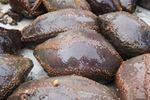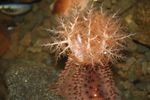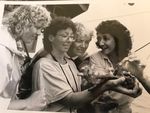Huntsman Turns 50! Education Department Turns 36!
←
→
Page content transcription
If your browser does not render page correctly, please read the page content below
Presented by the Huntsman Marine Science Centre, St. Andrews, NB Spring 2019
Excellence in Education, Research and Science since 1969
SeaWords is published twice a year
Huntsman Turns 50! Education Department Turns 36!
The Huntsman idea took root in 1967 when Dr. John “I think the greatest contribution the Huntsman will make to
Anderson became the director of the St. Andrews Biological Canada will come from its education programs, in particular
Station (SABS). He saw a need to revive research the ones for school children. Every time I see a group of
collaborations between government and universities, to elementary school students marching off to the mudflats, I
“ensure that young Canadian students were awakened to wonder how many are future A.G. Huntsmans who may later
the challenging opportunities afforded by a career in the count their experience in St. Andrews as the spark turning on
marine sciences”. the marine sciences’ light.”
- Dr. John Anderson
In 1969, Dr. Anderson’s idea became a reality and the Huntsman’s 30th anniversary annual report
Huntsman Marine Laboratory was founded. The name of the
laboratory was chosen to honour Dr. Archibald Gowanlock
Huntsman, who was a pioneer in Canadian fish biology and
oceanography, director of SABS from 1919-1934 and a
professor at the University of Toronto.
In 1987, the name became the Huntsman Marine Science
Centre to recognize that the organization had changed to be
more than just a field station.
Over the years the Education Department has evolved.
Many of the early school groups used to come on the train,
now they come on big coach buses or fly into the Saint John
airport. Groups were 15-20 students, now they can top 50
and fit into every nook and cranny of the student residences.
Some of the schools that participated in the early years still
The first high school courses were offered in 1978, with the come today. Relationships have been developed over 36
Public Education Department officially recognized in 1983. years. Each group receives an individualized schedule
In 1984, a two-hour program, aquarium tour, or slide based on their curriculum and interests. When the school
presentation cost $0.75 per student and $1.50 per adult and groups are here they take full advantage of the campus;
was only available during September. staying overnight in our residences, having meals in the
dining room, using the research vessel, and studying in the
Inka Milewski was the first coordinator of the department wet labs.
and began to draw participants from Quebec and Ontario on
a regular basis. Soon after the Education Department won As we look to the future we will continue our mission of
an award from the National Marine Educators Association. inspiring stewards of the marine environment one student
In presenting the award, Dr. Jim Lanier, a colleague from a group at a time! Everywhere we go, to teachers’
marine centre in North Carolina noted “that the Huntsman’s conferences or other events we are fondly greeted by
Public Education program is unique not only to the people remembering a time they came to the Huntsman as
Maritimes but to all of Canada.” a student.
12019 Summer Programs at the Huntsman Marine Science Centre
Young Explorer Weeks
Enjoy educational games, activities, crafts, animal encounters
and field excursions. Each week will cover different topics.
Programs run 9:30am to 3pm and are open to ages 5-11.
July 15 to 19 - Week 1
Introduction to Marine Biology July 29 to August 2 - Week 2
A hands-on experience in field biology. Discover the
diversity of invertebrates, fish, seabirds and mammals
living in and around the Bay of Fundy. Young Explorer Days
Open to students 15 to 18 years old Sharks, whales, seals or sea stars…no matter what your young
July 8th to 12th, 2019 explorer is passionate about, there’s a marine experience waiting
that is sure to surprise and delight! Programs run 9:30am to 3pm
and are open to ages 5-11.
Intro to Marine Mammals & Seabirds July 10 - Lobster Day
Discover the diversity of whales, porpoise, seals and July 17 - Microscopic Life Day
seabirds that live in and around the Bay of Fundy.
Open to students 15 to 18 years old July 24 - Shark Day
July 22nd to 26th, 2019 July 31 - Sea Star Day
August 7 - Seal Day
All Things Marine August 14 - Whale Day
A hands-on introduction to marine biology, with a little August 21 - Seabird Day
bit of maritime history.
Open to families & friends, 10 years old and over
July 30th to August 2nd, 2019
Jeunes Explorateurs
Booking, price and early-bird discount information available at Les après-midi des jeunes explorateurs pour les jeunes âgés
www.huntsmanmarine.ca. de 5 à 11 ans sont donnés les mardis 23 juillet et 13 août, de 13h
à 15h. Ce programme sera donné en français par un instructeur
bilingue.
About the Huntsman... Mardi le 23 juillet - Les requins
The Huntsman Marine Science Centre is a not-for-profit facility in St. Andrews,
N.B., dedicated to education, research and applied science. Thousands of
Mardi le 13 août - Les baleines
students come to our campus each year, from elementary school to university
level. We publish this newsletter specifically for teachers twice a year. If you
have any marine biology questions, feature ideas, or things you’d like to see us This program will be taught in French by a bilingual instructor.
cover, contact us at:
Huntsman Marine Science Centre
1 Lower Campus Road, St. Andrews by-the-Sea, NB E5B 2L7 Canada
506.529-1200 huntsman@huntsmanmarine.ca
Visit us online at www.huntsmanmarine.ca
Please register in advance for programs. Registration can be
completed by email lbarrett@huntsmanmarine.ca
or phone (506) 529-1226.
2All Things Marine: Above & Below Welcome Back!
We are very excited to announce the Huntsman was chosen to
receive a Trident Underwater Drone as part of the Science
Exploration Education (S.E.E.) Initiative with National
Geographic Open Explorer!
Before launching our Trident in the strong currents of the Bay of
Fundy we went for a test run in the pool at the local hotel. We
novices who didn't grow up with video games had a bit of a
learning curve with the controller. I am sure students will have
an easier time maneuvering the Trident.
A few bumps into the walls and along the bottom saw us
unintentionally test out the durability of the Trident. We didn't
see any marine life in the pool, but did end up giving one
swimmer a bit of a fright. We definitely need a second test run
before we launch our Trident in the ocean!
Deploying our Trident will allow students to see marine
creatures undisturbed in their natural environment. These
visuals will complement handling the real animals and increase
the understanding of life in the benthic environment.
Follow our expedition, All Things Marine: Above and Below,
online at National Geographic Open Explorer, https://
openexplorer.nationalgeographic.com/expedition/allthingsmarine. In April the Huntsman Education Department added a new staff
member, Taneesha Sharpe. Here she tells us a bit about herself.
Hi! My name is Taneesha. I am the Junior Education & Outreach
Officer here at the Huntsman Marine Science Centre.
I grew up in the small town of St. Stephen, New Brunswick. As a
child, I loved school and had a passion for learning. Somewhere
between writing pages of notes and doing dissections, I decided
to pursue biology. I completed the first half of a Bachelor of
Science in Biology at Acadia University. Feeling homesick, I
finished my degree a little closer to home at the University of
New Brunswick in Fredericton. During my time at UNB, I was a
volunteer tutor for Frontier College. As part of my volunteer
work, I was placed in a 3rd grade class at Barker Point School,
where I found my niche in teaching.
In my spare time, I coach competitive cheerleading, advocate for
mental health and talk about how much I love dogs to anyone
who will listen.
I really enjoyed my time in the education department as an intern
last summer and I’m ecstatic to be back again!
3Activity: Collect & Observe Plankton
Grade level:
Elementary and up
Purpose:
To learn about the life in a drop of water.
Background:
The word plankton is derived from a Greek word that means
drifter. These drifting organisms can range in size from tiny, microscopic
bacteria all the way up to large, jellyfish.
Plankton are divided into two groups, phytoplankton and
zooplankton. Phytoplankton use photosynthesis to grow, so require
sunlight, water, carbon dioxide and nutrients. They produce up to two- Sea Creature Facts: Orange-footed Cucumber
thirds of the oxygen on Earth and are the base of the marine food chain.
Phytoplankton are green-golden in colour, unicellular, many do not move
and they have simple shapes. This is the most common sea cucumber is the Bay of
Zooplankton are multicellular, transparent and have many weird Fundy. Its scientific name, Cucumaria frondosa literally
and wonderful shapes. Some zooplankton, such as copepods (ie. Plankton translates to leafy sea cucumber.
from SpongeBob), live their whole life in the plankton layer. Many animals
such as sea cucumbers, sea stars, crabs, lobsters and certain fish start their Insights
life in the plankton layer.
Materials: Fits in a group of animals called Echinodermata with
knee high pantyhose sea stars, sea urchins and sand dollars
wire coat hanger
glass jar with a lid Five bands of orange tube feet for movement and
duct tape attachment to the sea floor
elastic
plankton ID sheets 10 bushy tentacles around the mouth collect
microscope/hand lenses plankton and detritus
Procedure: Inserts tentacles into the mouth, one at a time, to
1. Introduce plankton to the students. remove trapped food
2. Construct the plankton nets. Shape the wire coat hanger into a circle.
Shape the hook into a handle. Breathe via the anus
3. Loop the cut edge of the panty hose around the wire circle. Use duct
tape to seal the seam. Fold duct tape over the wire and the panty hose Have a top and a bottom; underside often lighter in
to hold in place. colour
4. Place the open jar in the toe of the panty hose. Place the elastic around
the neck of the jar.
Sexes are separate; breed through broadcast
5. Slowly pull the plankton net behind a boat or behind you as you walk
spawning
along a shoreline or wharf. The net can also be placed into fast moving
water from a bridge or dock. Don’t let the net drag on the ground.
Larvae are planktonic
6. Look at the collected plankton using a microscope or hand lens.
7. Have students identify and draw the phytoplankton and zooplankton
Eaten as a delicacy in some countries
from the collected samples.
8. Extension: Can the students suggest ways to modify the plankton net
or make it better? Small local fishery in Southwest New Brunswick
9. Extension: Compare plankton collected from saltwater and freshwater.
Compare plankton collected at different times of the year.
10. Extension: What animals eat plankton? Construct a food chain that
includes plankton.
11. Extension: Play The Great Diatom Race www.huntsmanmarine.ca/wp-
content/uploads/2015/11/SeaWords-Fall-20151.pdf
4You can also read



























































